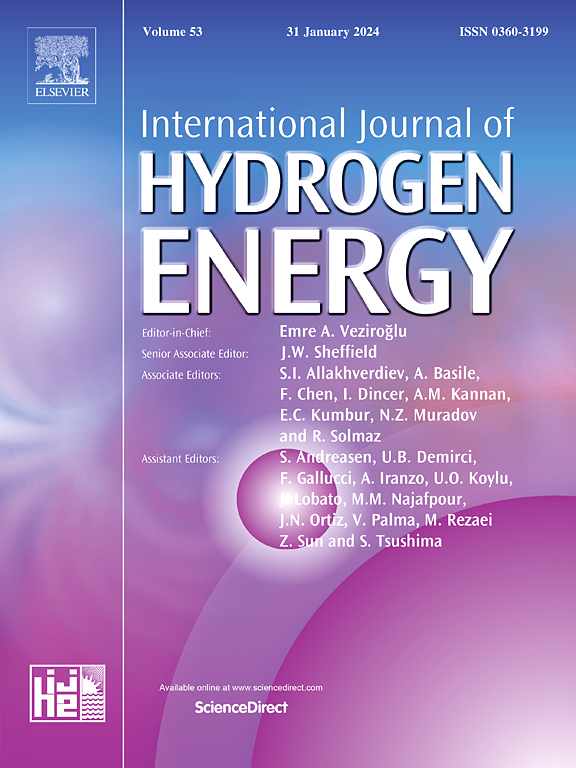Theoretical modeling of experimental isotherms for hydrogen storage in La0.9Ce0.1Ni5 alloy
IF 8.1
2区 工程技术
Q1 CHEMISTRY, PHYSICAL
引用次数: 0
Abstract
This research reports the results of an experimental and numerical analysis of the La0.9Ce0.1Ni5 alloy's hydrogen absorption and desorption isotherms at three distinct temperatures (T = 313 K, 333 K, and 353 K). We first determined the morphological and structural properties, as well as the hydrogen storage isotherms, of the intermetallic La0.9Ce0.1Ni5 experimentally. The experimental isotherms were then compared to a mathematical model based on statistical physical theory. Due to the good agreement between the experimental isotherms and the proposed model, the insertion and release of hydrogen atoms (nα, nβ), geometric densities of receptor sites (Nαm, Nβm), and absorption-desorption energies (Pα, Pβ) were determined. Moreover, thermodynamic functions like enthalpy, entropy, Gibbs free energy, and internal energy were calculated using these parameters. The findings demonstrated that the intermetallic compound's CaCu5 structure promotes the formation of stable metal hydrides through attractive interactions, ensuring that hydrogen atoms are securely trapped in the metal lattice, thereby enhancing the material's hydrogen storage capacity.
La0.9Ce0.1Ni5合金储氢实验等温线的理论建模
本文报道了La0.9Ce0.1Ni5合金在3种不同温度(T = 313 K、333 K和353 K)下的吸氢和解吸氢等温线的实验和数值分析结果。我们首先通过实验确定了金属间化合物La0.9Ce0.1Ni5的形态、结构和储氢等温线。然后将实验等温线与基于统计物理理论的数学模型进行了比较。由于实验等温线与模型吻合较好,我们测定了氢原子(nα, nβ)的插入和释放量、受体位点(nα m, nβ m)的几何密度以及吸解吸能(Pα, Pβ)。利用这些参数计算了热力学函数如焓、熵、吉布斯自由能和内能。研究结果表明,金属间化合物的CaCu5结构通过吸引相互作用促进稳定金属氢化物的形成,确保氢原子被安全地困在金属晶格中,从而增强了材料的储氢能力。
本文章由计算机程序翻译,如有差异,请以英文原文为准。
求助全文
约1分钟内获得全文
求助全文
来源期刊

International Journal of Hydrogen Energy
工程技术-环境科学
CiteScore
13.50
自引率
25.00%
发文量
3502
审稿时长
60 days
期刊介绍:
The objective of the International Journal of Hydrogen Energy is to facilitate the exchange of new ideas, technological advancements, and research findings in the field of Hydrogen Energy among scientists and engineers worldwide. This journal showcases original research, both analytical and experimental, covering various aspects of Hydrogen Energy. These include production, storage, transmission, utilization, enabling technologies, environmental impact, economic considerations, and global perspectives on hydrogen and its carriers such as NH3, CH4, alcohols, etc.
The utilization aspect encompasses various methods such as thermochemical (combustion), photochemical, electrochemical (fuel cells), and nuclear conversion of hydrogen, hydrogen isotopes, and hydrogen carriers into thermal, mechanical, and electrical energies. The applications of these energies can be found in transportation (including aerospace), industrial, commercial, and residential sectors.
 求助内容:
求助内容: 应助结果提醒方式:
应助结果提醒方式:


